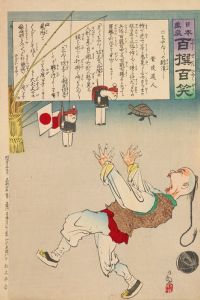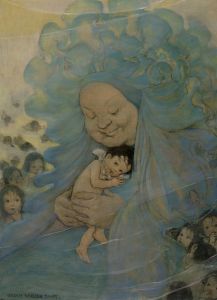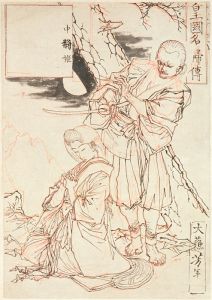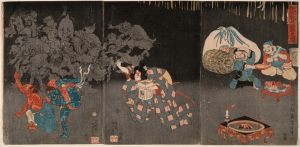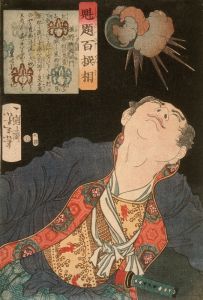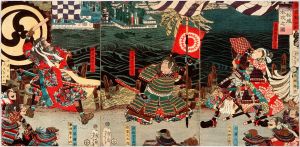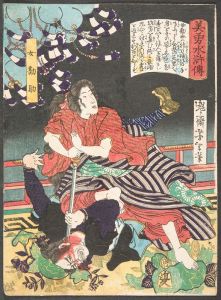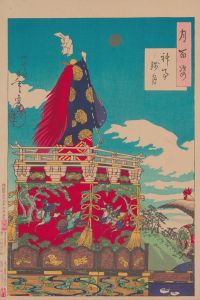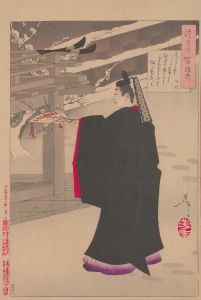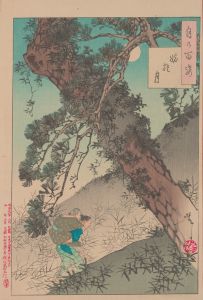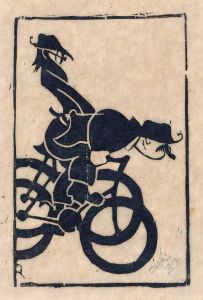
Matsugae Sekinosuke Glowering at a Rat
A hand-painted replica of Tsukioka Yoshitoshi’s masterpiece Matsugae Sekinosuke Glowering at a Rat, meticulously crafted by professional artists to capture the true essence of the original. Each piece is created with museum-quality canvas and rare mineral pigments, carefully painted by experienced artists with delicate brushstrokes and rich, layered colors to perfectly recreate the texture of the original artwork. Unlike machine-printed reproductions, this hand-painted version brings the painting to life, infused with the artist’s emotions and skill in every stroke. Whether for personal collection or home decoration, it instantly elevates the artistic atmosphere of any space.
Tsukioka Yoshitoshi (1839–1892) was a prominent Japanese ukiyo-e artist, widely regarded as one of the last great masters of the traditional woodblock printing technique. His works often explored themes of history, folklore, and the supernatural, blending dramatic imagery with intricate detail. Among his extensive body of work is the piece titled Matsugae Sekinosuke Glowering at a Rat, which exemplifies Yoshitoshi's skill in storytelling through visual art.
This artwork is part of Yoshitoshi's series New Forms of Thirty-Six Ghosts (Shinkei Sanjūrokkaisen), created between 1889 and 1892. The series features depictions of ghostly tales, legends, and supernatural events from Japanese folklore and history. Each print in the series combines Yoshitoshi's mastery of composition with his interest in the macabre and the mysterious.
Matsugae Sekinosuke Glowering at a Rat portrays a scene rooted in Japanese folklore. Matsugae Sekinosuke, a samurai, is shown in a tense moment, glaring at a rat. The rat is often interpreted as a supernatural entity or a symbol of an ominous presence, reflecting the themes of fear and the unknown that permeate the series. Yoshitoshi's use of bold lines and expressive facial features captures the intensity of Sekinosuke's emotions, while the detailed rendering of the rat adds to the eerie atmosphere of the piece.
The print demonstrates Yoshitoshi's innovative approach to ukiyo-e during a time when the art form was in decline due to the rise of Western-style painting and photography in Japan. Despite these challenges, Yoshitoshi's works maintained a strong connection to traditional Japanese aesthetics while incorporating modern influences, such as a heightened sense of realism and dynamic composition.
Yoshitoshi's New Forms of Thirty-Six Ghosts series, including Matsugae Sekinosuke Glowering at a Rat, remains highly regarded for its artistic and cultural significance. The series not only showcases Yoshitoshi's technical skill but also serves as a window into the rich tapestry of Japanese folklore and the enduring appeal of supernatural themes in art.
This particular print, like others in the series, was created using the traditional woodblock printing technique, involving collaboration between the artist, carvers, and printers. Yoshitoshi's designs were meticulously carved into woodblocks, which were then inked and pressed onto paper to produce the final image. The vibrant colors and fine details of the print highlight the craftsmanship involved in its creation.
Today, Matsugae Sekinosuke Glowering at a Rat is celebrated as a testament to Yoshitoshi's artistic legacy and his ability to evoke emotion and intrigue through his depictions of the supernatural. The print is often studied and exhibited as part of Yoshitoshi's broader contributions to the ukiyo-e tradition.






